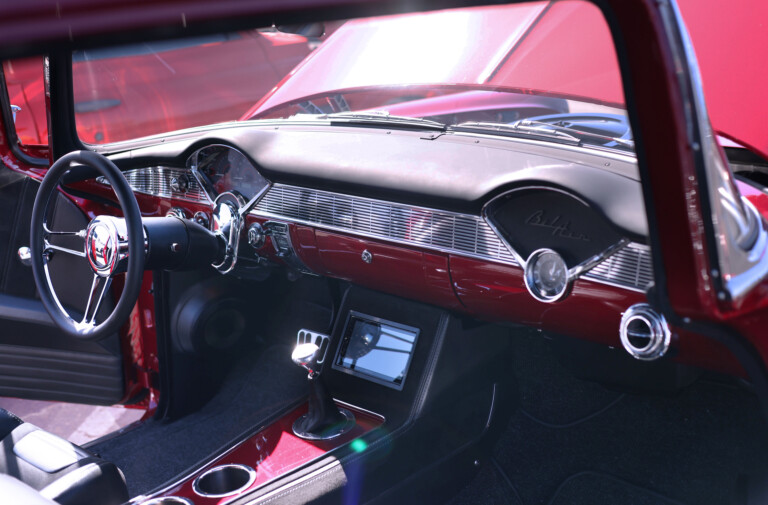In recent years, the Big Three have looked back to 1960’s for inspiration when it comes to designing their new cars. The Mustang, Camaro, and Challenger are all undeniably retro, some in more obvious ways than the other. While the engines and the looks and the interior features may have changed, some things remain the same, even forty years later. So how different, or similar, are the 2010 models to their 1970 counterparts?
We are going to break each car down according to its price (adjusted for inflation), weight, overall size, options, and horsepower as a measuring stick. First up is the original pony car, the Ford Mustang.
Ford Mustang: 1964 1/2 – 2010

Picture: Ford
By 1970, the Mustang had grown in size, weight, and price. The tiny coupe-that-could cost $2,721 for a standard, six-cylinder coupe in 1970, while a fastback Mach 1 Mustang cost $3,271, or about $17,872. The priciest Mustang you could buy was the $5,027 GT500 convertible. In today’s dollars, that is about $27,500. You got more car for your money though, as the Mustang grew in length by almost four inches, and widened by half an inch over the original model for a total length of 187.4 inches. This added about 140 pounds to the curb weight, which ranged between 2721 pounds and 3,240 pounds, depending on the engine choice.
Engines were getting bigger too. A 200 cubic inch inline six engine was standard, while the 302 became the standard V8. But the real power was in the big blocks, which ran up to a massive 429 cubic inch big block motor, with an estimated 375 horsepower. But this was the gross horsepower rating, which lacked front accessories like alternator and were given headers to boost power. This resulted in grossly exaggerated horsepower claims, and many of these classic V8 muscle cars barely make 200 horsepower at the wheels. Still, there were a lot more engine choices back in the day. If you include the different Boss and Cobra Jet engines, there were nine different engine choices in 1970 for the Mustang. The Boss was the big guns of the Mustang, based on the Trans Am cars, and made an estimated 315 horsepower. It also had an upgraded suspension, heavy duty transmission and radiator.
Technically, we are comparing the 2011 model, which sees significant changes from the 2010 model including three new engine choices. But they are without a doubt better engines, with even the base 3.5 liter V6 pumping out 305 horsepower. Meanwhile the new 5.0 engine has 412 horsepower, and the GT500’s 5.4 liter engine makes an astounding 550 horsepower. Of course, this all comes with an increased price. The new Mustang GT costs $30,495 off the showroom floor, and the GT500 costs near $50,000. Surprisingly, the new Mustang has similar dimensions to its predecessor, as in 2010 the Mustang is just one-half inch longer than in 1970. A GT coupe weighs in 3,533 pounds, but is much faster than even the 429-equipped models, and manages to get an estimated 26 mpg on the highway. The big blocks of yesterday used to pass everything but a gas station.
Chevrolet Camaro: 1967-2010

Picture: GM
Lets move on to the Camaro, which was Chevy’s answer to the Mustang. 1970 was an important year for all GM muscle cars, as it was the year GM lifted its ban on engines over 400 cubic inches on intermediary cars. While a 454 engine was slated to enter the 1970 Camaro, it never did, with the top engine instead being the 396 (which actually displaced 402 cubic inches). Other available engines included three different versions of the famous and popular 350, as well as a two base engines. a 250 V6 and a 307 V8. The Camaro had similar proportions to the Mustang, coming in at 188 inches and with a slightly higher curb weight, up to 3,313 pounds. But the Camaro was slightly more expensive than the Mustang, costing $2,749 for the base six-cylinder, while a base Camaro equipped with the top 396 engine would cost $3,224, which translates into $17,615 in today’s dollars. Of course, there were a plethora of options to check off, such as a heavy duty 4-speed transmission, air conditioning, or the $168 Rally Sport (RS) package. The $573 Z/28 package was the answer to the Mustang Boss, and featured a Corvette-inspired 350 V8 engine destroked to 305 cubic inches, suspension upgrades, and a 300+ horsepower rating.
Today’s choices are much simpler, with three engine choices, though the car itself is infinitely more complicated. You get either the 3.7 liter, 312 horsepower V6, a 400 horsepower L99 engine with the automatic SS car, or a 422 horsepower six-speed manual Camaro SS. The MSRP is $30,995, about $500 more than the 2011 Mustang GT. The Camaro is bigger than the Mustang by about 2 inches, coming in at 190 inches, and weighing over 3,700 pounds (depending on options). There is no Z/28 option yet, though it is in the works, which leaves us finally with the 2010 Challenger R/T.
Dodge Challenger 1970 – 2010

Picture: Chrysler
Just like its modern counterpart, the 1970 Challenger was the biggest of the Big Three’s pony cars, coming in at 191 inches in length. It was also by far the heaviest, coming in at over 3,400 pounds. With eight engine options, from a 198 Slant Six to the infamous HEMI 426, the Challenger likely offered the most horsepower. There was also the famous 440 Six Pack engine available on the R/T, which was more popular than the expensive HEMI. While the 440 engine was a $250 option, the HEMI cost almost $780, which would cost $4,280 in today’s dollars. A base Challenger Six started at $2,851, while the R/T with the 340 V8 cost $3,266, or $17,845 in 2009 dollars. Adding just a HEMI would bring the price to over $4,000. Like the Mustang and Camaro, there were many options including heavy duty transmissions and axles, the Trans Am package, power sunroofs, and the famous Mopar Colors. Only Mopar could paint your challenger Plum Crazy or Panther Pink.
The 2010 Challenger is the biggest and heaviest car of the lot. It is also arguably the most retro-looking in comparision. At over 197-inches in length and weighing in at over 4,100 pounds, it dwarfs the competition. This comes from having been based on the LX sedan chassis. It too offers just three engines; the 3.5 liter, 250 horsepower V6, a 376 horsepower 5.7 liter HEMI, and a monster 6.1 liter 425 horsepower HEMI on the SRT8 model. This is still a much smaller engine than the original HEMI, but likely makes even more horsepower. A Challenger R/T today has an MSRP of $30,800, slotted nicely in between the Mustang and Camaro, though the SRT8 model costs nearly $40,000. But perhaps the biggest difference is the lack of a convertible model. The Mustang already has convertibles, and the Camaro is getting one next year. Yet while we were teased by Challenger convertible concepts, a production model never came to be.
There are some pretty big differences these days, especially in what we pay. The muscle cars of yesterday are priced in the range of economy cars today, which is perhaps why Ford sold two million Mustangs in just five years. These days, selling 100,000 muscle cars is considered a good year. That is because a V8 car costs at least $30,000 these days, which pretty much signifies the end of cheap muscle. Or maybe not.
These days, the V6 Mustang and Camaro come standard with over 300 horsepower, which is nothing to sneeze at. While still starting in the $22,000 range, both of these would outrun their classic V8 counterparts handily. There is no doubt today’s cars are much better, but will they be remember with the same fondness? We think so. Anyway, here is a bullet-point breakdown of the cars.
1970 Mustang
- Price Range: $2,721 – $5,027
- Available Engine Sizes: 200 – 250 – 302 – 351 – 428 – 429
- Dimensions: Length: 187.4-inches Width: 71.7-inches Weight: 2,720-3,240 pounds
2011 Mustang
- Price Range: $22,145 – $49,495
- Available Engine Sizes: 3.7 liter – 5.0 liter – 5.4 liter Supercharged
- Dimensions: Length: 188.1-inches Width: 73.9-inches Weight: 3,605 – 3,770 pounds
1970 Chevy Camaro
- Price Range: $2,749 – $3,224
- Available Engine Sizes: 250 – 307 – 350 – 396
- Dimensions: Length: 188-inches Width: 74.1-inches Weight: 3,313 pounds
2010 Camaro
- Price Range: $22,245 – $33,430
- Available Engine Sizes: 3.6 liters – 6.2 liters
- Dimensions: Length: 190-inches Width: 75.5-inches Weight: 3,750-3,860 pounds
1970 Challenger
- Price Range: $2,851 – $4,044
- Available Engine Sizes: 225 – 340 – 383 – 426 Hemi – 440
- Dimensions: Length: 191-inches Width: 76.1-inches Weight: 2,790 to 3,395 pounds
2010 Challenger
- Price Range:
- Available Engine Sizes: 3.5 liter – 5.7 liter – 6.1 liter
- Dimensions: Length: 197 inches Width: 75.1 inches Weight: 4,144 pounds
Right from the start, we can see that Dodge’s entry, the Challenger R/T has always remained a heavier – and larger – option for the pony car enthusiast. Mustangs remained true to their lightweight, smaller platform even until today while Camaro has gone through several iterations. So, who’s the winner? We want all of you to chime in.





















